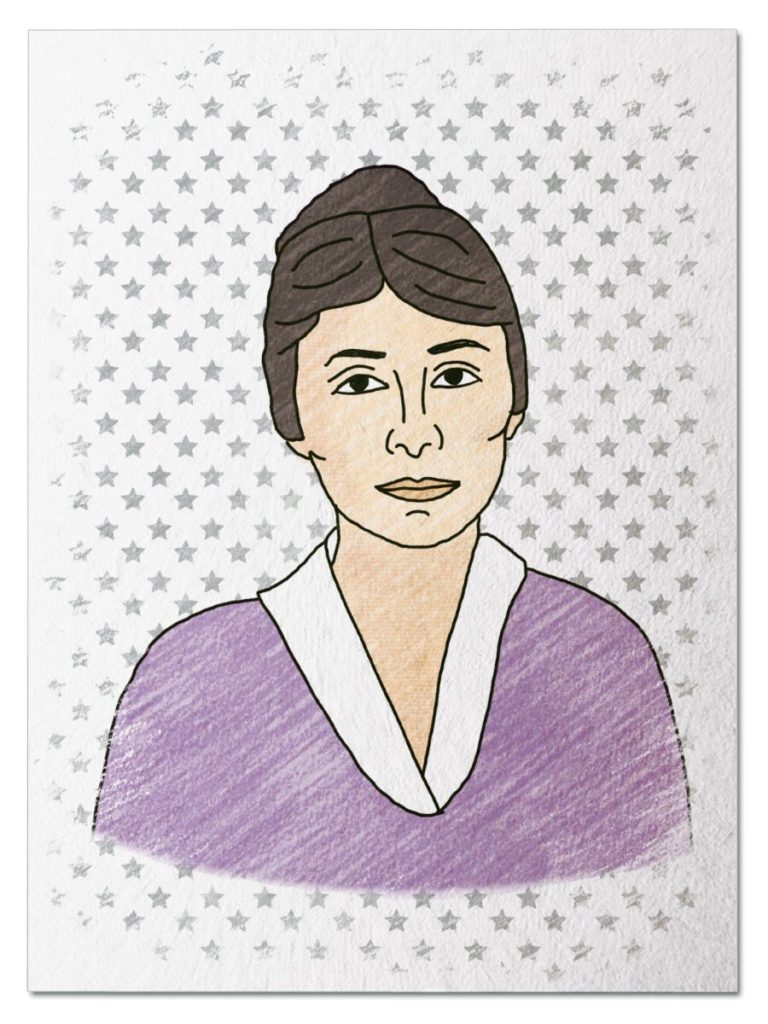
Amazing Artist
She grew up in on a farm in Wisconsin, surrounded by nature, and took art lessons in painting, drawing, and pottery at home from a private tutor. After graduating high school, she enrolled in art classes and earned a living as an art teacher until she gained the confidence to create her own style of abstract art. To her surprise, her work was featured in an art gallery in New York City. Before long, her work was famous throughout America. Eventually, however, the wide open spaces of nature called her once again. Travel back to the American Southwest in 1929 and meet Georgia O’Keeffe …
Her Ruby Shoe Moment
The Power of the Wand
Her Yellow Brick Road
Brains, Heart & Courage
Glinda’s Gallery
Just the Facts
Her Ruby Shoe Moment
Georgia O’Keeffe smiled as she looked at the endless sky. It was the summer of 1929 and she had just arrived in New Mexico. After spending the last 10 years on the East Coast, she felt like she could finally breathe again.
While living in New York City, Georgia was part of an avant-garde group of artists, les by her husband, Alfred Steiglitz. He displayed her work at his art gallery and promoted her as a “feminine artist.” But Georgia wanted to manage her own reputation — her move to New Mexico was part of her effort to replace her image as a “woman artist” with that of a hard-working, professional artist.
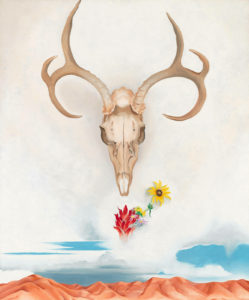
Georgia O’Keeffe, Summer Days (Whitney Museum of American Art)
Georgia loved everything about the American Southwest — the harsh light; the vivid colors; the endless sky; the stark and rugged terrain; the wild and free landscape; the adobe architecture; and the Native American and Hispanic cultures. The desert was beautiful and provided new inspiration for her art.
For the next 20 years, Georgia spent the winters in New Mexico. She reveled in the solitude and focused on her painting. She transformed her car into a portable art studio, then traveled throughout the Southwest. She collected items along the way that spoke to her, such as animal skulls, bleached bones, and interesting rocks. And she sketched everything she saw, from mountains to adobe churches.
Georgia painted abstract versions of her drawings and found objects. She painted the landscapes on large canvases, cropped close to focus on the lines. She focused on the shapes and colors she saw in nature — her goal was to paint nature in a way that showed how it made her feel. She wanted to get to the heart of a subject. And she painted a subject over and over until she was satisfied that she had captured its “essence.” Before long Georgia became famous for the art she made in the desert.
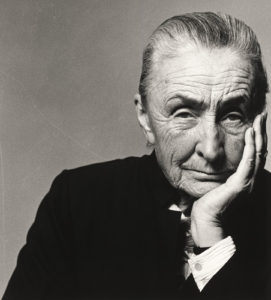
Georgia O’Keeffe by Philippe Halsman (National Gallery of Art)
Every winter, Georgia brought her paintings back to New York City and offered them for sale in Stieglitz’s gallery. While in the city, however, she longed to return to the desert. After Stieglitz died, Georgia left the art scene in New York City and moved to New Mexico permanently in 1949.
Georgia lived in New Mexico for 40 more years. She eventually owned two homes near Santa Fe — a summer home in the mountains called Ghost Ranch and a casita in the town of Abiquiú. The Ghost Ranch became a pilgrimage for thousands of aspiring artists. Everyone wanted to visit the recluse artist, Georgia O’Keeffe in the desert. The American Southwest became known as “O’Keeffe country.”
When she was about 73 years old, Georgia’s vision began to decline. She was diagnosed with macular degeneration, which caused her vision not deteriorate over the years. Eventually, she was nearly blind. But she didn’t let it stop her. She painted her last piece independently in 1972. After that, she continued to make art from her memory of images, with assistance, until she was 86 years old. Her art depicted images from her lifetime of memories.
The Power of the Wand
Georgia O’Keeffe was a pioneer of modern art in America — her work focused on abstract lines, simple shapes, and bold color. Over the course of her 70 year career, Georgia created more than 2,000 works of art. She became the first female painter to gain respect in New York’s art world in the 1920s. And she paved the way for generations of painters.
The Georgia O’Keeffe Museum opened in 1997 in Santa Fe, New Mexico — it was the first museum in the United States dedicated to a female artist. Its Art and Leadership Program provides young artists in middle school with the opportunity to develop their creativity and grow in their self expression and confidence.
Her Yellow Brick Road
Georgia was nervous as she left the post office in Amarillo, Texas. She had just mailed some of her abstract charcoal drawings to a friend and former classmate in New York City. Her friend had agreed to show Georgia’s work around the New York art scene. It was the first true test of her abstract work. Eventually, Georgia’s work made it to Alfred Steiglitz, a famous photographer and gallery owner in New York. He was captivated.
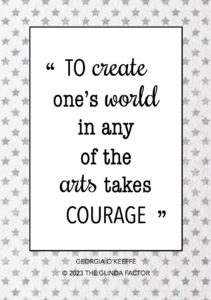 Steiglitz organized an exhibition of Georgia’s work, without her knowledge, at his Gallery 291. And it was a huge success. Steiglitz offered to support Georgia for one year, so she could focus on her art. She took him up on his offer and moved to New York City in 1918. She was drawn to the skyscrapers of Manhattan, which were a sign of the modern age. She focused one the lines of the buildings, as well as the shadows created at street level. Her work looked like urban canyons.
Steiglitz organized an exhibition of Georgia’s work, without her knowledge, at his Gallery 291. And it was a huge success. Steiglitz offered to support Georgia for one year, so she could focus on her art. She took him up on his offer and moved to New York City in 1918. She was drawn to the skyscrapers of Manhattan, which were a sign of the modern age. She focused one the lines of the buildings, as well as the shadows created at street level. Her work looked like urban canyons.
Georgia and Steiglitz started a relationship shortly after she moved to New York and married in 1924 (they were 24 years apart). It was a complicated relationship that was both personal and professional — he was one of the biggest champions of her work. They were at the heart of the New York art scene, spending the winters in New York City and summers at the Steiglitz family home on Lake George in upstate New York.
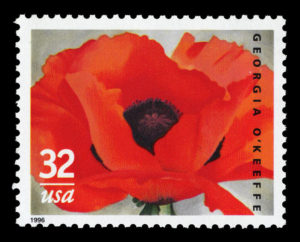
Georgia O’Keeffe postage stamp (US Postal Museum)
While spending the summers upstate, Georgia painted what she saw in nature all around her. She had amazing powers of observation and could see the subtle nuances of lines and colors in even the tiniest objects. In 1924, she focused on the colors and lines within flowers. She magnified a tiny portion of a flower on a huge canvas. It was a combination of realism and abstracts that was a style all her own.
Before long, Georgia was recognized as one of the most significant American artists of the 1920s. The unusual compositions of her skyscraper and flower paintings established her reputation as an innovative modern artist. But she grew restless. She had grown bored with Lake George and tired of the New York social scene. So she decided to return to the Southwest in search of creative inspiration.
Brains, Heart & Courage
Georgia grew up on a dairy farm in Wisconsin with six siblings (she was the second oldest). Georgia learned to draw and paint as a child, receiving lessons at home. Her mother encouraged her to study art from an early age and arranged for additional watercolor and pottery lessons with a local artist. She also took music lessons and was a talented musician.
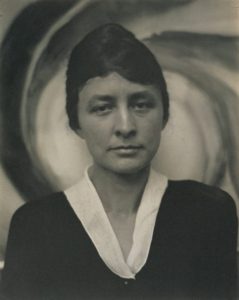
Georgia O’Keeffe by Alfred Stieglitz (Georgia O’Keeffe Museum)
When Georgia was 10 years old, her family moved to Virginia. After graduating from a Catholic high school, studied at both the Art Institute of Chicago and the Art Students League in New York City. At the time, all art students learned the techniques of traditional painting and imitative realism.
Georgia excelled in all her classes, and even won an award for one of her still-life oil paintings while at the Art Students League. But she felt that something was missing. As a result, she didn’t think she could be successful as a professional artist. So she worked as a commercial artist in Chicago for a few years. She continued to look for other opportunities, however. And thought about the idea of teaching art to high school students.
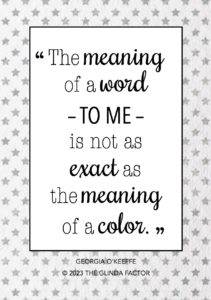 While she was in between jobs, Georgia spent a summer with her family back in Virginia. While there, she took a class for art teachers at the University of Virginia, Charlottesville. It was taught by a professor from the Teachers College at Columbia University. He noticed her talent and introduced her to his colleague, Arthur Wesley Dow.
While she was in between jobs, Georgia spent a summer with her family back in Virginia. While there, she took a class for art teachers at the University of Virginia, Charlottesville. It was taught by a professor from the Teachers College at Columbia University. He noticed her talent and introduced her to his colleague, Arthur Wesley Dow.
Dow had a revolutionary view of art — he believed it should be a personal expression of the artist, rather than imitate reality. He also emphasized that art should be harmonious, drawing from the Asian principles of design and art. His ideas spoke to Georgia and she began to find her own style. She experimented with lines and shapes in charcoal drawings. The more she experimented, the more her confidence grew. For over 10 years, Georgia worked nonstop to perfect her own style of art. Finally, in 1916, at the age of 29, she was ready to share her work with others.
Glinda’s Gallery
Just the Facts
- Georgia was born on November 15, 1887 in Sun Prairie, Wisconsin.
- Georgia created over 2,000 artworks over the course of her life.
- Georgia was honored with 3 retrospectives shows: 1943 at the Art Institute of Chicago; 1946 at the Museum of Modern Art (its first retrospective of work by a woman); and 1970 at the Whitney Museum of American Art. She was also awarded membership in the American Academy of Arts and Letters, the Medal of Freedom in 1977, and the National Medal of Arts in 1985.
- Georgia wrote her autobiography, Georgia O’Keeffe (1976), and participated in a film about her life, Georgia O’Keeffe (1977).
- Georgia died on March 6, 1986 in Santa Fe, New Mexico at age 99.
Want to Know More?
The Georgia O’Keeffe Museum (www.o’keeffemuseum.org)
Cowart, Jack, Juan Hamilton, and Sarah Greenough. Georgia O’Keeffe: Art and Letters. Exhibition catalogue. Washington, DC: The National Gallery of Art, 1987.
Lisle, Laura. Portrait of an Artist: A Biography of Georgia O’Keeffe. New York: Washington Square Press, 1997.
Messinger, Lisa Mintz. Georgia O’Keeffe. London: Thames & Hudson, 2001.
O’Keeffe, Georgia. Georgia O’Keeffe. New York: Viking, 1976.
Robinson, Roxana. Georgia O’Keeffe: A Life. Waltham, MA: Brandeis University Press, 2020.
